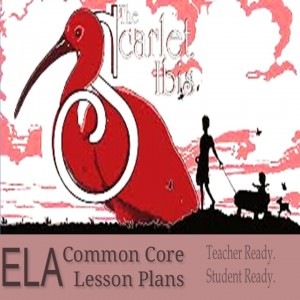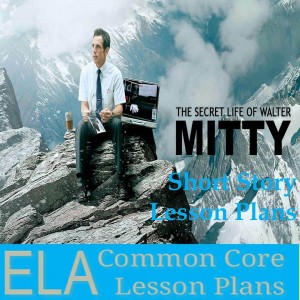Short Stories for Teaching Imagery in Literature
Imagine if your students could actually recognize and make sense of imagery. This should help.
ELA Common Core Standards Covered
Teaching imagery in short stories may cover the following ELA Common Core Standards. This is for your administrator, not your kids. Kids need student-friendly worded objectives.
- RL.9-10.1 Cite strong and thorough textual evidence to support analysis of what the text says explicitly as well as inferences drawn from the text.
- RL.9-10.2 Determine a theme or central idea of a text and analyze in detail its development over the course of the text, including how it emerges and is shaped and refined by specific details; provide an objective summary of the text.
- RL.9-10.4 Determine the meaning of words and phrases as they are used in the text, including figurative and connotative meanings; analyze the cumulative impact of specific word choices on meaning and tone (e.g., how the language evokes a sense of time and place; how it sets a formal or informal tone).
- RL.9-10.10 By the end of grade 9, read and comprehend literature, including stories, dramas, and poems, in the grades 9-10 text complexity band proficiently, with scaffolding as needed at the high end of the range. By the end of grade 10, read and comprehend literature, including stories, dramas, and poems, at the high end of the grades 9-10 text complexity band independently and proficiently.
Imagery in Literature Defined
We all teach that imagery is the use of vivid or figurative language to represent objects, actions, or ideas, but teaching mastery requires learning more than just a definition. Here are the levels of learning in regards to teaching imagery:
- Define imagery: You can teach a monkey to recite a definition. It’s simple memorization. It is necessary for mastery but does not come close to achieving it.
- Find examples of imagery: You’d have trouble teaching a monkey to identify imagery (unless it’s a really smart monkey). Most high school students know it when they see it. Simply identifying it, however, has no practical application outside of a classroom. It is not mastery.
- Interpret imagery: Now we’re approaching mastery. Students who can explain the author’s purpose in using a particular image, the connotative meaning of the image, and how the image relates to the overall theme of the literary work are using critical thinking skills, skills that can be applied outside of the classroom.
- Create imagery with a purpose: Students who can use imagery to suit a specific purpose in writing or in speech have mastered the concept and are one step closer to becoming a master of words.
Short Stories with Examples of Imagery
Quick Note: Click on the stories with links if you’re looking for full units on those specific stories. You’ll be glad you did.
Once students are able to define imagery, it’s time to model the above skills by using short stories with examples of imagery. For the purpose of teaching imagery, read as a class and stop when you find examples of imagery. Write the example on the board. Discuss its interpretation and purpose. For some examples you may need to wait until the story’s finished.
“The Scarlet Ibis” by James Hurst opens with “It was in the clove of seasons, summer was dead but autumn had not yet been born, that the ibis lit in the bleeding tree.” Hurst uses personification-“summer was dead”-an ominous beginning. The image of a bleeding tree, the clove-a red flower-and the ibis-which we know to be scarlet-are connotative of blood and death. The remainder of the opening paragraph contains the following images: rotting brown magnolia petals, rank iron weeds, an empty cradle, graveyard flowers whose smell drifted through every room of the narrator’s house. It doesn’t take Shakespeare to figure out this story will be about death.
- “Catch the Moon” by Judith Ortiz Cofer uses imagery in the title. A title analysis to begin the story inspires thinking beyond facts and events. Drawing pictures on white boards or discussing what the phrase “catch the moon” might mean make good motivation activities. The narrator’s description of the food his mother cooked before her death lends the passage a sense of nostalgia and alerts the reader to the protagonist’s longing for his mother. The image of the moon in the tree outside of Naomi’s window is another important image worth discussing.
- Dylan Thomas’s “A Child’s Christmas in Wales,” although not technically a short story, reads like a narrative and contains multiple examples of imagery. One reads of “Christmases [that] roll down toward the two-tongued sea, like a cold and headlong moon bundling down the sky that was our street,” and other images that evoke a sense of nostalgia. Because of its numerous examples, identifying images should be easy.
- “The Secret Life of Walter Mitty” by James Thurber employs imagery to enhance the quality of Walter Mitty’s dreams: “The commander’s voice was like thin ice breaking. He wore his full-dress uniform, with the heavily braided white cap pulled down rakishly over one cold gray eye.”; “A door opened down a long, cool corridor and Dr. Renshaw came out. He looked distraught and haggard.”; and “War thundered and whined arond the dugout and battered at the door. There was a rending of wood and splinters flew through the room” all provide a stark contrast to the mundane life Mitty actually leads.
The preceding examples of imagery come from the following works.
- Hurst, James. “The Scarlet Ibis.” Timeless Voices, Timeless Themes. New Jersey: Prentice Hall. 2002, pp. 554-64.
- Thurber, James. “The Secret Life of Walter Mitty.” Timeless Voices, Timeless Themes. New Jersey: Prentice Hall. 2002, pp. 347-52.
- Cofer, Judith Ortiz. “Catch the Moon.” Glencoe Literature. New York: McGraw Hill. 2002, pp. 63-72.
- Thomas, Dylan. “A Child’s Christmas in Wales.” Glencoe Literature. New York: McGraw Hill. 2002, pp. 433-44
Teaching Literary Elements with Short Stories
Understanding literary elements is necessary for literary analysis. These short stories will help you teach literary elements.
- The Best American Short Stories
- Short Stories for Teaching Theme
- Short Stories for Teaching Irony
- Short Stories for Teaching Symbolism
- Short Stories for Teaching Conflict
- Short Stories for Teaching Foreshadowing
- Short Stories for Teaching Imagery
- Short Stories for Teaching Characterization

